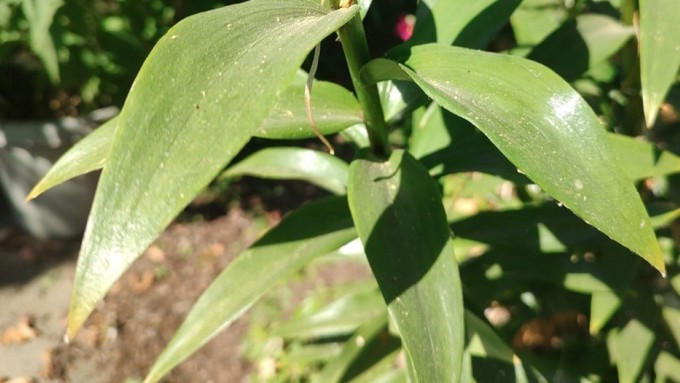
Triple-digit temperatures and smoky conditions can create high pollutant levels

Ash collects on the leaves of a large lily plant. Debbie Arrington
Maybe consider wearing a facemask while gardening?
Ash on the leaves of plants is a reminder: With wildfire smoke comes fine particulate matter. That stuff can get in your lungs – as well as clog plant pores.
So far this wildfire season, we’ve been relatively lucky in Sacramento; our air quality has remained “moderate” to “unhealthy for sensitive people” instead of downright unhealthy for everyone.
We already have unhealthy heat; the National Weather Services issued a “heat advisory” for the Sacramento region through Wednesday night with highs of 107 to 112 degrees possible.
Triple-digit heat coupled with wildfire smoke can create another problem for plants: Ozone damage. It starts out as stippling – little dots all over large leaves. Or parts of leaves or petals may look like they were sun-bleached white or silver.
Ozone is what happens when wildfire ash and other pollutants get “cooked” by temperatures more than 100 degrees. It makes our eyes water and throats hurt. (Think of a real smoggy day.)
While ozone high up in the atmosphere is a good thing, ground-level ozone can be very bad. In Sacramento’s case, it can be created by a combination of wildfire ash and other pollutants (usually nitrogen oxides and volatile organic compounds), intensified by bright sunlight and triple-digit heat.
Ground-level ozone can prevent a plant's leaves from properly doing their job. Ozone enters the leaf's stomata and burns the leaf's tissue.
Signs of ozone damage include dark stippling and bleaching of foliage. Plants lose their vigor and stop blooming or yielding fruit. Ozone damage weakens the plant and makes it much more susceptible to pests and disease.
Some plants are more prone to ozone damage than others. Researchers at the National Park Service surveyed plants in national parks and found hundreds of species with ozone sensitivity, ranging from asters to elderberries, sycamores and yarrow. Various maple, cherry, poplar and plum trees are all on the ozone-sensitive list.
In the meantime, tackle the ash and heat with the same remedy – water. Keep plants hydrated. Wash ash and soot from leaves. And look forward to lower temperatures later this week; more normal temperatures will not only bring some relief from the heat but reduce the change of ozone damage.
Comments
0 comments have been posted.Sacramento Digs Gardening to your inbox.
Food in My Back Yard Series
May 6: Maintain soil moisture with mulch for garden success
April 29: What's (already) wrong with my tomato plants?
April 22: Should you stock up on fertilizer? (Yes!)
April 15: Grow culinary herbs in containers
April 8: When to plant summer vegetables
April 1: Don't be fooled by these garden myths
March 25: Fertilizer tips: How to 'feed' your vegetables for healthy growth
March 18: Time to give vegetable seedlings some more space
March 11: Ways to win the fight against weeds
March 4: Potatoes from the garden
Feb. 25: Plant a fruit tree now -- for later
Feb. 18: How to squeeze more food into less space
Feb. 11: When to plant? Consider staggering your transplants
Feb. 4: Starting in seed starting
Sites We Like
Garden Checklist for week of May 11
Make the most of the lower temperatures early in the week. We’ll be back in the 80s by Thursday.
* Plant, plant, plant! It’s prime planting season in the Sacramento area. Time to set out those tomato transplants along with peppers and eggplants. Pinch off any flowers on new transplants to make them concentrate on establishing roots instead of setting premature fruit.
* Direct-seed melons, cucumbers, summer squash, corn, radishes, pumpkins and annual herbs such as basil.
* Harvest cabbage, lettuce, peas and green onions.
* In the flower garden, direct-seed sunflowers, cosmos, salvia, zinnias, marigolds, celosia and asters. (You also can transplant seedlings for many of the same flowers.)
* Plant dahlia tubers.
* Transplant petunias, marigolds and perennial flowers such as astilbe, columbine, coneflowers, coreopsis, dahlias, rudbeckia and verbena.
* Keep an eye out for slugs, snails, earwigs and aphids that want to dine on tender new growth.
* Feed summer bloomers with a balanced fertilizer.
* For continued bloom, cut off spent flowers on roses as well as other flowering plants.
* Add mulch to the garden to maintain moisture. Mulch also cuts down on weeds. But don’t let it mound around the stems or trunks of trees or shrubs. Leave about a 6-inch-to-1-foot circle to avoid crown rot or other problems.
* Remember to weed! Pull those nasties before they set seed.
* Water early in the day and keep seedlings evenly moist.